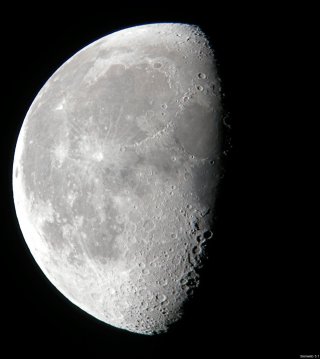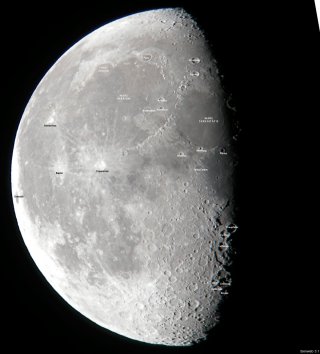The last week of the lunation is turning into a test of endurance. Waking at 3 a.m. to get moon shots is not ideal for those of us who have day jobs. On the plus side, though, I have upgraded to CS4 and am able to annotate the photos; I’m working on the backlog and will post updates as time permits.
This morning’s moon turned out fairly well, despite the vibrations from the passing train and the clouds I had to dodge now and then (fortunately it wasn’t the other way around; dodging trains is one thing, but vibrating clouds would really make we worry!):
This moon’s seas are rapidly disappearing. Crisium disappeared into darkness days ago; Mare Nectaris joins it in obscurity today, and Mare Tranquillitatis is so far gone (though still visible) that I didn’t even label it. You can still make out the eastern fringes of Mare Serenitatis, but you can tell that it’s next on the chopping block. A prominent system of wrinkle ridges (dorsa; singular dorsum) runs for nearly 500 km down the entire eastern side of Serenitatis. Formerly known (informally) as the Serpentine Ridge, this prominent feature of the third quarter moon has been subdivided and given individual names (who knew that real estate investors and lunar nomenclaturists had the same idea about subdivisions?). From south to north the components of the serpentine ridge are: Dorsum Nicol, after a Scottish physicist from the 18th Century, William Nicol (he invented the first device for obtaining plane-polarized light, the Nicol Prism); Dorsa Lister, after Martin Lister, the 17th-century British zoologist, and the first to propose a modern geologic survey; and the largest system of wrinkle ridges in the chain, Dorsa Smirnov, after a prominent naturalist from the former Soviet Union, Sergei S. Smirnov, about whom even Wikipedia knows very little.
One of the craters featured last night, Posidonius, is just barely visible today. Last night its eastern rim wall was shining in the sunset; today it’s the western wall that is being highlighed by the setting sun. At the southern end of Serenitatis, on the border with the Sea of Tranquility is the prominent crater Plinius, named after Pliny the Elder, author of the first-century encyclopedia Historia Naturalis.
Continuing south along the terminator we meet again with the prominent trio Theophilus, Cyrillus, and Catharina, and then the quartet Zagut, Lindenau, Rabbi Levi, and Riccius in the cratered highlands of the moon’s southern hemisphere. It’s easy for the astronomer at the eyepiece to get lost in this rugged terrain, which is part of the reason I’m taking the trouble to hand label each of these images. I figure after a month of this, I should be able to find my way around a little bit better!



